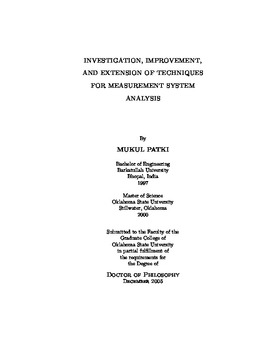| dc.contributor.advisor | Case, Kenneth | |
| dc.contributor.author | Patki, Mukul | |
| dc.date.accessioned | 2013-12-10T18:05:05Z | |
| dc.date.available | 2013-12-10T18:05:05Z | |
| dc.date.issued | 2005-12 | |
| dc.identifier.uri | https://hdl.handle.net/11244/7779 | |
| dc.description.abstract | Purpose and scope of study: Critical manufacturing decisions are made based on data obtained by randomly sampling production units. The effectiveness of these decisions depends on the accuracy of the data, which in turn depends on the accuracy and precision of the measurement system. A measurement system is comprised of two primary components - equipment or measuring devices and appraisers or personnel who use these devices. Each component adds to the variability of the data. The process of analyzing this variation and estimating the contribution of various components of the measurement system toward this variation is known as measurement system analysis (MSA). | |
| dc.description.abstract | Automotive Industry Action Group (AIAG) has been at the forefront of MSA research. Through this dissertation, (I) improvements have been made in some of the existing estimates of variance components (part variation); (ii) new variance components have been identified and quantified (within-appraiser variation); (iii) new approaches have been suggested (using multiple measuring devices); (iv) the estimates of variance components when measurement is destructive have been improved and adapted for chemical and process industries; and (v) various measurement system acceptability criteria have been identified and their relative merits and demerits have been evaluated under varying process capability conditions. Monte-Carlo simulation is used to verify the techniques developed as a part of this research. | |
| dc.description.abstract | Research contributions and conclusions: Within-appraiser variation is found to be confounded with equipment variation. Lower bound for the former and upper bound for the latter are estimated using two different approaches. The use of multiple equipment in the MSA study allows the estimation of variation among equipment which can be a significant component of the observed variation, and yet, is ignored in the current state of MSA. The traditional estimate of part-to-part variation is corrected. Concurrent evaluation of various measurement system acceptability criteria revealed that some of these are in conflict with each other. Guidelines for the use of these criteria are developed. The difference between two such criteria-discrimination ratio and number of distinct categories, are outlined. The current MSA approach for destructive testing scenarios is significantly improved and new estimates for measurement variation are derived. | |
| dc.description.abstract | All simulation tests were done on a MATLAB-based software developed as part of this research. This software allows the simulation and analysis of various measurement systems under widely varying conditions. | |
| dc.format | application/pdf | |
| dc.language | en_US | |
| dc.rights | Copyright is held by the author who has granted the Oklahoma State University Library the non-exclusive right to share this material in its institutional repository. Contact Digital Library Services at lib-dls@okstate.edu or 405-744-9161 for the permission policy on the use, reproduction or distribution of this material. | |
| dc.title | Investigation, improvement and extension of techniques for measurement system analysis | |
| dc.contributor.committeeMember | DeYong, Camille | |
| dc.contributor.committeeMember | Kamath, Manjunath | |
| dc.contributor.committeeMember | Payton, Mark | |
| dc.contributor.committeeMember | Pratt, David | |
| osu.filename | Patki_okstate_0664D_1587.pdf | |
| osu.accesstype | Open Access | |
| dc.type.genre | Dissertation | |
| dc.type.material | Text | |
| thesis.degree.discipline | Industrial Engineering and Management | |
| thesis.degree.grantor | Oklahoma State University | |
